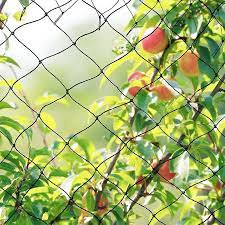
Harnessing the Power of Netting: A Gardener’s Guide to Enhancing Garden Health and Yield
Introduction: In the intricate tapestry of gardening, challenges often lurk beneath the surface, threatening the health and vitality of our cherished plants. Whether it’s voracious pests, unpredictable weather, or the constant battle against disease, gardeners must employ a range of strategies to protect their green sanctuaries. Amidst these challenges, garden netting emerges as a versatile and indispensable tool, offering a myriad of benefits for garden health and yield. In this article, we will delve into the multifaceted role of netting in gardens and explore how it can transform your gardening experience.
1. Pest Exclusion: Pests can wreak havoc on a garden, decimating crops and leaving devastation in their wake. Garden netting serves as a formidable barrier against these intruders, preventing insects, birds, and small animals from accessing vulnerable plants. The fine mesh of the netting acts as a physical barrier, effectively deterring pests without the need for harmful chemicals. By covering garden beds or individual plants with netting, gardeners can protect their harvests and ensure a more abundant yield.
2. Bird Protection: Birds, while delightful to observe, can pose a significant threat to garden crops, particularly ripening fruits and tender shoots. Garden netting provides an effective solution by creating a barrier that denies birds access to valuable harvests. The mesh structure of the netting allows sunlight and rain to penetrate while keeping birds at bay, preserving fruits and vegetables until they are ready for harvest. With strategic placement, Netting For Garden allows gardeners to enjoy the beauty of birds without sacrificing their crops.
3. Weather Resilience: The whims of weather can be unpredictable, subjecting gardens to harsh sunlight, strong winds, heavy rain, and even hailstorms. Garden netting serves as a protective shield against these elements, providing plants with much-needed shelter and protection. During periods of intense heat, netting can offer shade, reducing the risk of sunburn and heat stress. In regions prone to hailstorms, netting can prevent damage to delicate foliage and fruits, ensuring a more resilient garden ecosystem.
4. Support for Climbing Plants: Many garden plants benefit from vertical support as they grow, including peas, beans, cucumbers, and tomatoes. Garden netting offers an ideal solution for training climbing plants, providing a sturdy yet flexible structure for vines to climb. By installing netting trellises or frames, gardeners can maximize space in their garden beds and improve air circulation around plants. The result is healthier, more productive plants and easier harvesting of fruits and vegetables.
5. Disease Prevention: Plant diseases can spread rapidly in garden environments, posing a constant threat to plant health and productivity. Garden netting acts as a physical barrier, preventing the spread of diseases by reducing contact between plants and inhibiting the transmission of pathogens. By minimizing the risk of infection, netting helps maintain plant health and reduces the need for chemical interventions, fostering a more sustainable and resilient garden ecosystem.
Conclusion: In the ever-evolving world of gardening, netting emerges as a valuable ally, offering a range of benefits for garden health and yield. From pest exclusion to weather resilience and disease prevention, the versatility of garden netting makes it an indispensable tool for gardeners of all levels. By incorporating netting into garden designs and maintenance practices, gardeners can create healthier, more productive growing environments and enjoy bountiful harvests season after season.